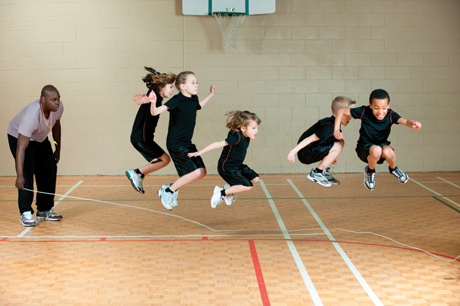Fitness vs. Academics: The PE Tug-of-War

Like a lot of kids, I loved gym class growing up, but I recall it being a lesson in survival. We would go home wearing welts from rubber dodge balls — if I had knocked out a good number of classmates before getting hit myself, I considered it a good day. Friends remember the discomfort of kickball games when team captains picked their players one by one. The great relief was to not be that last little kid standing against the fence.
These days, a parent visiting a local elementary school might find students working in teams as they unicycle, play Double Dutch jump rope and spot each other on a climbing wall. The parent could also hear kids learning about the effects of stress on a body, how to recognize abusive situations, and why high-fructose corn syrup is a bad thing. That modern parent could rightly conclude that this isn’t their parents’ physical education class.
In its 2012 Shape of the Nation Report, the National Association for Sport and Physical Education finds that the more balanced approach to physical education (PE) not only makes it a better experience for the less athletic student, it dramatically expands the skills — including academic ones — that each participant gains: social, cooperative and problem-solving skills, as well as tools for self-assessment and decision making. “The benefits of physical education extend outside the gym or playing field and across a student’s entire education experience,” the report states.
Physical education should support physical activity, says Bryan Pule, the physical education teacher at Whittier Elementary School in Seattle. “Kids have talents in different areas, so what we want for them is to set their own goals, really work to achieve them and take control of their own fitness.”
Chuck Millsap, a PE instructor at Whitman Middle School in Seattle (he previously taught at the elementary level), believes that this subject area, with the state-mandated Health and Fitness Learning Standards adopted in 2008, has evolved more in the past decade than any other subject area. “I do feel like I make a difference, especially with kids who may not have the support at home,” he says.
Integrity and more
PE instructors now teach self-discipline, perseverance, integrity and leadership. Students learn what a target heart rate is, about flexibility and muscular endurance, and about different intensity levels of exercise. They also learn why fruit-based smoothies are a better nutritional choice than a Red Bull. The range of instructional material is vast, but no less critical to a child’s success than spelling or geometry, instructors believe.
In grades K–8, Washington students are required to get an average of 100 minutes of physical education per week. The state does not mandate, however, how much of that PE time should be actual physical activity. In fact, Washington does not require elementary schools to provide daily recess.
Some schools offer before-school, lunchtime or after-school fitness sessions to give kids the chance to actually get their blood moving and their heart rates up. “For adults, it’s exercise; for kids, it is play,” says Pule.
Tahoma High School PE instructor Jeana Haag developed a program to integrate lessons on academic concepts such as anatomy, physiology and nutrition into active movement sessions. “As physical educators, we do not want to give up activity time for a ‘sit-down’ lesson,” Haag says.
Then there’s the obesity issue. “Obesity is a disease at this point,” says Lisa Rakos, the health and fitness supervisor for Washington’s Office of the Superintendent for Public Instruction. “There are different health issues now than 10 years ago.”
The reality is that American children and adolescents are a sedentary bunch, spending 22–28 hours per week viewing television, according to the Kaiser Family Foundation. The Centers for Disease Control and Prevention reports that Washington state’s obesity rate ticked up in 2011 to 26.5 percent.
Problems: time and money
But as critical as health and fitness lessons seem to be, there is a tug-of-war between PE programs and core subjects, such as math, reading and writing. “Biggest challenge: not having enough time with students,” says Alice Atha, the physical education specialist at Riverview Elementary School in Vancouver, Wash. “My 500 students, grades kindergarten through fifth, have PE twice a week for 30 minutes. They would love to have it every day.”
Elementary school students like those at Whittier may rotate schedules, so that children may get PE classes every day for a week, but that’s only every other week or every third week. “It’s difficult to teach the standards the state puts out,” says Millsap. “You can’t teach the curriculum when kids aren’t in class.”
For other districts, particularly those with older-model facilities, the constraints are physical. In Mercer Island School District’s three elementary buildings, the gym and cafeteria are the same room: If the kids are eating lunch, the room can’t be used for PE.
Since schools and principals are not judged on how fit their students are, physical education gets second-class treatment in perennially tight school budgets, where there is often no line item for PE programs. PTAs, PTOs and grants can be the sole source of funds for a school’s physical education equipment, programs and teacher training.
And the older kids? In high school (grades 9–12), students must take the equivalent of one PE course credit or its equivalent, unless waived.
Pay attention to the operative phrase, “unless waived.” Fitness educators describe the waiver form, signed at the discretion of each school principal, as a laundry list of ways students can bypass the PE requirement. This includes participation in sports outside of school, religious reasons and physical disabilities. Students can also sidestep PE mandates if they’re taking “a full academic course load.” That means the student takes all academic classes — with no free periods.
Of Seattle Public Schools’ (SPS) approximately 49,000 students in 2012–2013, Millsap says, more than 6,000 sixth- through 12th-graders got a waiver for PE. Lori Dunn, SPS physical education program manager, is working this year to standardize the waiver process throughout the district’s middle and high schools, saying that she believes strongly in the link between PE and academic achievement.
Rakos believes families need to understand how physical education enhances students’ academic performance. When Bryan Pule challenges students three times a year to turn off the TV for a week and substitute physical activity, reading or games, he is teaching lessons many American adults should hear. Where parents fall short on health and fitness, the shape of Washington’s kids is in the hands of their PE teachers.
Hilary Benson is TV editor for ParentMap. She also blogs about the prevalence and prevention of youth sports injuries at playitsafesports.com.











